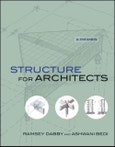An introduction to the concepts and principles of architectural structures in an easy-to-read format
Written as an easy-to-understand primer on the topic, Structure for Architects engages readers through instruction that uses a highly visual format and real-world examples to underline the key facets of structural principles that are essential to the design process. Eschewing complicated mathematics and technical jargon, Structure for Architects demystifies the subject matter by showing it in the context of everyday situations, giving architects and architectural technologists a clear understanding of how to incorporate structural principles into their designs.
Highlights of this book include:
-
A rich collection of drawings, photographs, and diagrams, spread throughout the text, which demonstrate fundamental structural concepts using everyday examples
-
An overview of structural design basics, as well as a summary of structural forms
-
A look at the design implications of steel, reinforced concrete, and wood
By providing an overall view of structures that covers the essentials of what architects and architectural technologists need to know, Structure for Architects is a valuable tool for illustrating the importance of designing with structure in mind and for learning the basics that are necessary for collaborating confidently with project team members.
Table of Contents
PREFACE IX
CHAPTER 1 Architects, Engineers, and Design 1
CHAPTER 2 Stability and Strength 5
CHAPTER 3 Loads 7
3.1 Gravity Loads 7
3.2 Lateral Loads 7
3.3 Dynamic Loads 10
3.4 Impact Loads 12
3.5 Load Paths 12
CHAPTER 4 States of Stress 17
4.1 Tension 17
4.2 Compression 17
4.3 Shear 18
4.4 Torsion 19
4.5 Bending 19
CHAPTER 5 Forces, Movement, Levers, and Moment 23
5.1 Applied and Reactive Forces 23
5.2 Translational Movement 23
5.3 Rotational Movement 24
5.4 Levers 24
5.5 Moment 25
CHAPTER 6 Stability and Equilibrium 27
6.1 Introduction 27
6.2 Translational Equilibrium 27
6.3 Rotational Equilibrium 28
6.4 Sign Conventions 29
6.5 The Equilibrium Equations 29
6.6 Free-Body Diagrams and Familiar Examples of Equilibrium 30
6.7 Introduction to Bending in Beams 39
CHAPTER 7 Working with Forces 41
7.1 Forces, Vectors, and Lines of Action 41
7.2 Combining and Resolving Concurrent Forces 44
7.3 Familiar Examples of Concurrent Forces 49
CHAPTER 8 Supports, Reactions, and Restraint of Movement 55
8.1 Roller and Frictionless-Surface Supports 55
8.2 Pinned Supports 56
8.3 Fixed Supports 58
8.4 Hanger Supports 60
8.5 Familiar Examples of Support Conditions 61
8.6 Stable or Unstable? 74
CHAPTER 9 Load Distribution 79
9.1 Point Loads 79
9.2 Distributed Loads 80
9.3 Equivalent Point Loads 81
9.4 Uniformly Distributed Loads 82
9.5 Non-Uniformly Distributed Loads 85
CHAPTER 10 Introduction to Beams 87
10.1 Beam Types 87
10.2 Predicting Deformation, Deflection, and Beam Behavior 88
10.3 Statically Determinate and Statically Indeterminate Beams 90
10.4 Other Considerations for Beams 94
CHAPTER 11 Framing Systems and Load Tributary Areas 99
11.1 One-Way Systems 99
11.2 Two-Way Slab and Beam Systems 103
11.3 Two-Way Slab/Two-Way Joist Systems 106
CHAPTER 12 Shear and Moment Diagrams for Beams 109
12.1 Sign Conventions 109
12.2 Typical Shear and Moment Diagrams 110
12.3 Creating Shear and Moment Diagrams 114
12.4 Comparing V and M for Uniformly Distributed Versus Concentrated Loading 120
12.5 Summary of Deformation, Shear, and Moment Relationships 123
CHAPTER 13 Stress, Strain, and Properties of Materials 125
13.1 Stress 125
13.2 Strain 126
13.3 Stress versus Strain 127
13.4 Properties of Materials 129
13.5 Stress Distribution Diagrams 130
CHAPTER 14 Introduction to Columns 131
14.1 Columns, Compression, and Bending 131
14.2 Column Loading 131
14.3 Column Compression 134
14.4 Column Bending 135
14.5 Leonhard Euler and Column Buckling 139
CHAPTER 15 Frames, Rigidity, and Lateral Resistance Systems 141
15.1 Triangular Frames 141
15.2 Rectangular Frames 141
15.3 Making Rectangular Frames Rigid 142
15.4 Lateral Resistance Systems 145
CHAPTER 16 Introduction to Trusses 151
16.1 Introduction 151
16.2 Trusses as Beams 152
16.3 Types of Trusses 154
16.4 Design Considerations 155
16.5 Truss Joints 157
16.6 Truss Loading 158
16.7 Truss Analysis 159
CHAPTER 17 Structural Walls 171
17.1 Loads and Deformational Stresses 172
17.2 Stresses and Wall Construction 173
17.3 Retaining Walls 175
CHAPTER 18 Soils and Rock 183
18.1 The Earth’s Interior 183
18.2 The Earth’s Crust 183
18.3 Natural Soils 186
18.4 Groundwater 186
18.5 Engineered Fill 187
18.6 Foundation Settlement 187
18.7 Soil-Bearing Capacity and Subsurface Conditions 187
CHAPTER 19 Foundations 189
19.1 Shallow Foundations 189
19.2 Deep Foundations 197
CHAPTER 20 Summing Up 199
APPENDIX 1 Structural Forms 201
APPENDIX 2 Structural Materials - Steel 211
A2.1 Composition and Manufacture 211
A2.2 Characteristics and Properties 211
A2.3 The American Institute of Steel Construction 212
A2.4 Grades of Structural Steel 212
A2.5 Shapes and Forms 212
A2.6 Joining Steel 214
A2.7 Decking 223
A2.8 The Design/Fabrication/Erection Process 224
A2.9 Related Terms 224
APPENDIX 3 Structural Materials - Reinforced Concrete 229
A3.1 Composition and Manufacture 229
A3.2 Curing 230
A3.3 Characteristics and Properties 231
A3.4 Related Terms 231
APPENDIX 4 Structural Materials - Wood 233
A4.1 Source and Manufacture 233
A4.2 Products 234
A4.3 Characteristics and Properties 236
A4.4 Structural Considerations 236
A4.5 Related Terms 237
APPENDIX 5 Properties of Sections 239
A5.1 Center of Gravity and Centroids 239
A5.2 Moment of Inertia 242
A5.3 Section Modulus 247
A5.4 Radius of Gyration 250
APPENDIX 6 Basic Trigonometry 257
A6.1 Basic Trigonometric Functions of a Right Triangle 257
A6.2 Basic Trigonometric Values of Frequently Used Angles 257
A6.3 Proportions of Special Right Triangles 258
A6.4 The Pythagorean Theorem 258
INDEX 259







